Indoor and outdoor soccer shoes differ significantly and are tailored to the playing surface. Indoor shoes feature a flat outsole, while outdoor cleats have studs for traction.
Delving into soccer, one must recognize the importance of suitable footwear. Soccer enthusiasts know the critical role shoes play in performance and safety. Whether battling it out on indoor courts or sprinting across grassy fields, choosing between indoor and outdoor soccer shoes is pivotal.
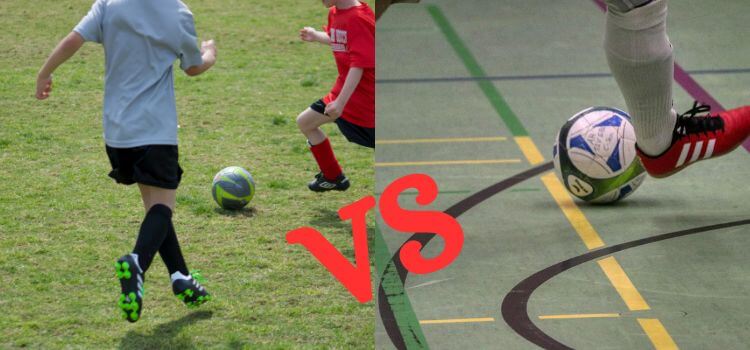
Each Type is engineered to master the player’s interaction with the ground, governing their agility and stability. This article will compare indoor vs. Outdoor soccer shoes, highlighting the design, traction, and material differences essential for peak performance. With function and form in mind, let’s kick off this comparison and help soccer players make the informed choice that could sway the game in their favor.
The Essential Differences
Choosing the right soccer shoes is crucial for performance and safety. Indoor and outdoor soccer shoes differ significantly. Each Type is tailored to its environment. Let’s dive into their essential differences.
Design Philosophy
Indoor soccer shoes prioritize flexibility and comfort. They fit closely to the foot, offering excellent control. Outdoor soccer shoes, in contrast, focus on durability. They also provide protective features for different types of outdoor pitches.
Sole Characteristics
The soles make all the difference. Indoor shoes feature a flat, non-marking rubber sole. This provides grip on smooth indoor surfaces. Outdoor soccer cleats have protruding studs or blades. These dig into the grass for stability.
| Feature | Indoor Soccer Shoes | Outdoor Soccer Shoes |
| Material | Lightweight synthetics | Durable leathers or synthetics |
| Sole Type | Flat rubber | Studded or bladed |
| Surface Compatibility | Hard indoor courts | Grass or turf fields |
Remember, using the wrong Type of shoe on the incorrect surface can lead to slips and injury. Pick the shoe that matches your playing surface for optimal play.
Exploring Traction And Grip
The proper traction and grip are critical for soccer players to execute sharp turns and maintain stability during a game. Different playing surfaces require distinct features in a shoe’s sole to optimize a player’s performance. Let’s dive into the nuances of indoor surfaces and outdoor terrain and how soccer shoes are designed to meet these conditions.
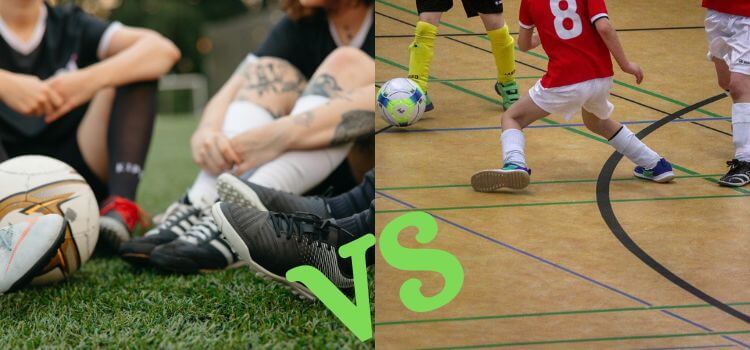
Indoor Surfaces
Indoor soccer shoes boast a flat, non-marking rubber sole. This design provides the necessary grip on smooth, slick surfaces without leaving scuff marks. The sole often features a pattern to maximize surface contact and improve control.
- Gum rubber outsoles for superior grip on indoor courts
- Enhanced treads for better traction during rapid movements
- Lightweight construction for increased agility
Outdoor Terrain
Outdoor soccer shoes, or cleats, have studs or blades for traction. These penetrate natural grass and synthetic turf, offering stability and preventing slippage. The studs’ arrangement and shape vary with the playing surface.
| Type of Cleat | Feature | Benefit |
| FG (Firm Ground) | Conical or bladed studs | Stability on natural grass |
| AG (Artificial Ground | Shorter, numerous studs | Better grip on synthetic fields |
| SG (Soft Ground) | Longer, replaceable studs | Penetration on wet, muddy pitches |
- Different lengths and shapes for studs tailored to field conditions
- Durable materials for long-lasting performance outdoors
- Optimized configurations for maximum traction and control
Durability And Material
Begin blog post section on Durability and Material of Indoor vs. Outdoor Soccer Shoes.
Regarding soccer footwear, the right pair can drastically change the game. Indoor and outdoor soccer shoes differ not just in style but also in the materials used and their durability. Let’s dive into how these shoes are crafted for their respective environments and what that means for players on the pitch.
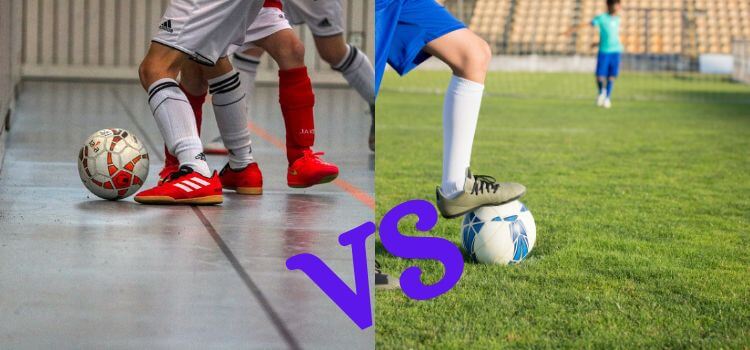
Adaptation To Surface
Soccer shoes must adapt to the surfaces they encounter. Indoor soccer shoes feature a flat, non-marking gum rubber sole designed to grip smooth surfaces like gym floors. On the other hand, outdoor soccer cleats have studs or blades that dig into grass or turf, providing stability and traction.
Longevity In Different Environments
The environment plays a vital role in the longevity of soccer shoes. Indoor shoes often utilize lightweight materials for flexibility and comfort, which may wear down quickly on harsh surfaces. Conversely, outdoor cleats must endure natural elements like mud, grass, and rain, so they’re constructed with more durable materials like synthetics or leather.
Indoor soccer players might find their shoes last longer if only used on proper indoor courts. Outdoor players must replace their cleats periodically due to the wear and tear of natural play conditions.
| Shoe Type | Main Materials | Expected Lifespan |
| Indoor Soccer Shoes | Synthetic blends, Gum rubber | 1-2 years (indoor use) |
| Outdoor Soccer Cleats | Leather, Synthetic leather, Plastic or metal studs | 6 months – 1 year (regular play) |
“` This HTML content segment for a WordPress blog post discusses the durability and material differences between indoor and outdoor soccer shoes. The discussion focuses on how each shoe type adapts to specific playing surfaces and the expected longevity in their respective environments, using h3 headings, paragraphs, and a comparative table for clarity and SEO optimization.
Shoe Design And Player Performance
Regarding soccer, the right shoe can make all the difference. Whether it’s an indoor court or an outdoor field, players need footwear designed for the game’s demands. Shoe design significantly impacts player performance, affecting everything from movement to comfort. Let’s dive into how indoor and outdoor soccer shoes compare.
Movement And Agility
Indoor soccer shoes are designed for flat surfaces. They feature a non-marking rubber sole that maximizes grip on smooth courts. This allows players to move swiftly and turn quickly without slipping. Outdoor soccer cleats, on the other hand, have spiked bottoms. These dig into grass or turf, providing stability for dynamic sprints.
Impact On GamePlay
The design of soccer shoes affects every touch and strike. Indoor shoes usually have a flatter surface for better ball control in fast-moving indoor games. With their spikes and studs, outdoor boots offer more power and precision on uneven outdoor terrains.
| Feature | Indoor Soccer Shoes | Outdoor Soccer Cleats |
| Material | Synthetic or leather, light cushioning | Durable synthetic or leather, reinforcement for rough play |
| Design | Low-profile, flat rubber sole for grip | Textured soles, cleats, or studs for traction |
| Usage | Indoor courts | Natural grass, or artificial turf fields |
Choosing the correct Type of shoe is critical, not just for optimal performance but also to prevent injuries. A player in the wrong Type of shoe may struggle to keep up and risk slipping, tripping, or suffering from impact injuries.
Considerations When Choosing Soccer Shoes
When searching for the perfect soccer shoes, weighing several factors is essential. Your comfort, performance, and safety all hinge on the right choice. Diverse options exist for different environments. Whether dodging opponents indoors or sprinting across an outdoor field, the decision matters.
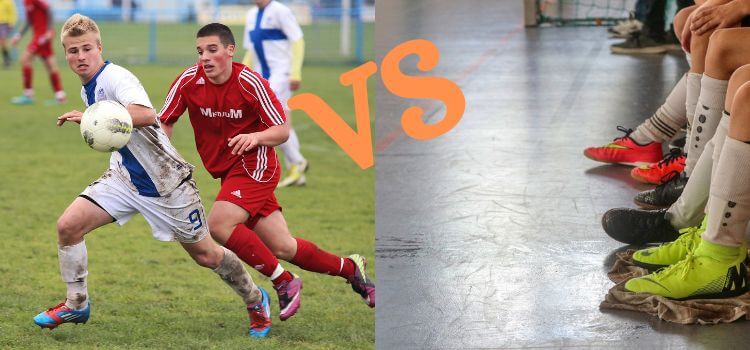
Player Preferences
Players must consider personal comfort and style. Some aspects to reflect on include:
- Fit: Secure yet flexible to avoid blisters.
- Weight: Light shoes allow swift movements.
- Material: Breathable fabrics reduce sweat.
Compatibility With Playing Surface
The Type of surface you play on influences shoe selection significantly.
| Surface Type | Indoor Soccer Shoes | Outdoor Soccer Shoes |
| Gym Floors | Flat soles for grip | Not Recommended |
| Artificial Turf | Short-studded shoes for traction | Longer cleats for stability |
| Grass | Not suitable | Studded cleats for grip |
Match your shoes to your playing surface to enhance performance and prevent injuries.
Common Myths And Misconceptions
Choosing the right soccer shoes is crucial for your game. Yet, many players get tangled in myths. Let’s dispel the common misconceptions about indoor and outdoor soccer shoes.
Interchangeability Of Shoes
A common myth is that indoor and outdoor soccer shoes are the same. This is not true. Each Type has features unique to the playing surface. For example, outdoor cleats have studs for traction on grass. Indoor shoes have flat soles for hard surfaces. These differences are essential for performance and safety. Using the wrong Type can lead to injury or decreased effectiveness on the field.
Influence On Skill Development
Another misconception is that shoes affect skill development. Some believe that a more expensive shoe will make them play better. The truth is skills are honed through practice, no matter the shoe. However, the right Type of shoe can enhance comfort and reduce injury risk. This, in turn, allows players to focus on improving their game without distractions.
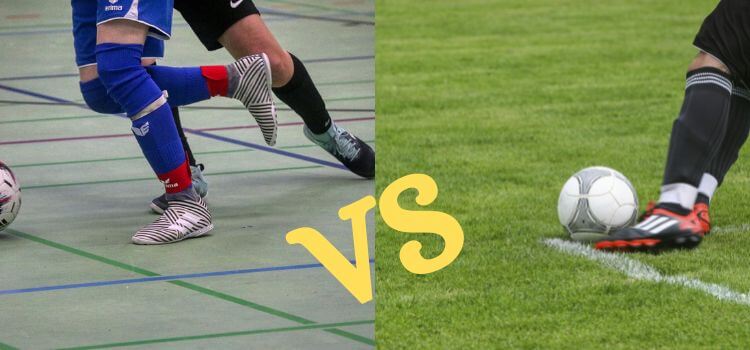
Features of Indoor and Outdoor Soccer Shoes
| Shoe Type | Surface | Cleat/Stud Pattern | Material | Fit |
| Outdoor | Grass/Turf | Conical or Bladed Studs | Durable Upper Materials | Snug to Allow for Stud Pressure |
| Indoor | Flat Surfaces (Wood, Court) | Flat Soles with Pattern Grip | Lightweight Materials | Close Fit for Ball Control |
Frequently Asked Questions To Write A Comparison Article On Indoor Vs. Outdoor Soccer Shoes.
Is There A Difference Between Indoor And Outdoor Soccer Shoes?
Yes, indoor and outdoor soccer shoes differ. Outdoor shoes feature studs for traction on grass, while indoor shoes have a flat, non-marking rubber sole for hard surfaces.
What Makes Indoor Soccer Shoes Different?
Indoor soccer shoes feature a flat, non-marking rubber sole for grip and are lighter than outdoor cleats.
Can Indoor Soccer Shoes Be Worn Outside?
Indoor soccer shoes can be worn outside but could be better, as they lack the traction needed for outdoor surfaces.
What Is The Difference Between Turf And Indoor Soccer Shoes?
Turf soccer shoes have small rubber studs for traction on artificial turf. Indoor soccer shoes feature a flat, non-marking rubber sole for grip on flat indoor surfaces.
Conclusion
Selecting the right soccer shoes significantly impacts your game, whether you play indoors or outdoors. Each Type offers unique features tailored to their respective playing environments. Remember, indoor soccer shoes prioritize flat soles for grip on smooth surfaces, while outdoor cleats ensure traction on grass or turf. Ultimately, your choice hinges on where you often play – indoor courts or the vast outdoor fields. Choose wisely to enhance your control and performance, and ensure you’re always one step ahead on the soccer pitch.
Related posts:
- Volleyball Vs. Tennis Shoes
- Canvas Vs. Leather Ballet Shoes
- Baseball Cleats Vs. Softball Cleats
- Snow Shoes Vs. Crampons
- Neutral Vs. Stability Running Shoes
- Foot Locker Vs. Finish Line
- On Cloud Vs. Nike
- Baseball Shoes Vs Football Shoes: Ultimate Performance Guide
- Turf Shoes Vs Softball Cleats: Which is Best for Your Game?
- Volleyball Shoes Vs Sneakers: The Ultimate Performance Showdown
